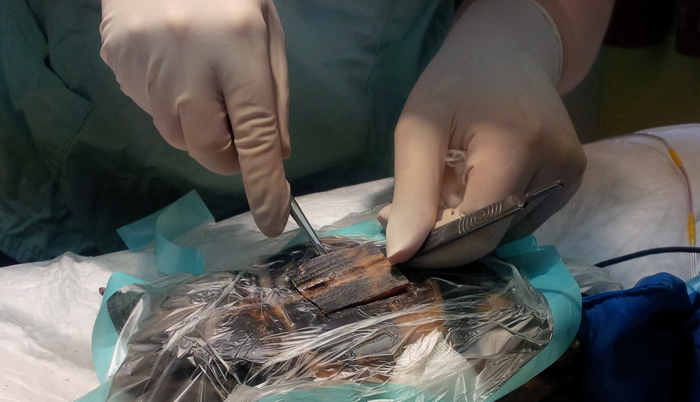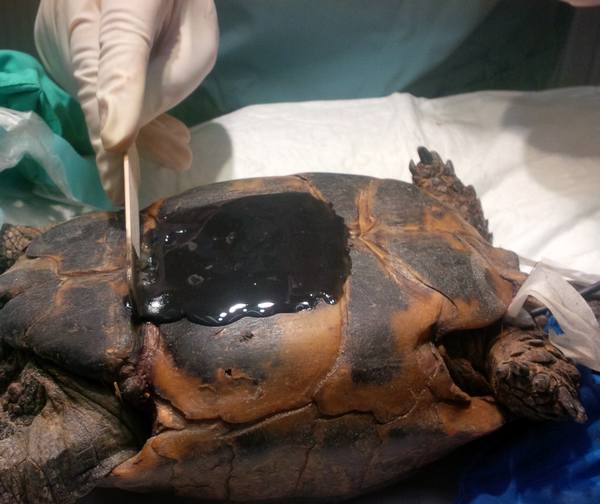
Veterinary services in East Anglia, with a love of all things exotic

Veterinary services in East Anglia, with a love of all things exotic

Shelly the tortoise is an old lady and when she first started slowing down her owner didn’t think much of it. But when her appetite started reducing she got worried and brought Shelly in to see Catherine.
A faecal sample revealed that she had some intestinal parasites and Catherine identified a few minor things which could be improved in her environment. So these things were changed and she was treated for the parasites.
Unfortunately Shelly didn’t seem to show any improvement even after successful treatment of the parasites and improvements to her husbandry. So she came back for investigation. X-rays didn’t show anything significant. A blood sample was taken and when they results came back they showed a strong indication that there were problems with Shelly’s reproductive system. An ultrasound scan revealed multiple round balls in the area where her ovaries should be. This allowed us to reach a diagnosis of follicular stasis. This means that Shelly’s ovaries were producing lots of follicles but the follicles were not being ovulated and developing into eggs. So her ovaries were filling up and the resulting hormones were having effects on her other organs and her calcium metabolism. Shelly’s owner had to think long and hard about agreeing to surgery, particularly with Shelly’s advanced age, but in the end she decided that it was the best thing for her.

So Shelly was booked in for surgery. On the day of her surgery she was admitted and put under a heat lamp to keep her warm until it was time for her surgery. She was weighed and her doses worked out and prepared. She was given some strong pain relief and some antibiotics to prevent infection, along with a mild sedative. While the medications were getting to work theatre and all of the anaesthetic equipment was prepared for her. Once everything was ready and Shelly was showing signs of being just a little sleepy she was taken to theatre. She was given an injection of an anaesthetic induction agent into the jugular vein in her neck which sent her off to sleep so that a tube could be placed in her windpipe and she was connected up to the anaesthetic machine so that we could provide her with oxygen and a gaseous anaesthetic. A machine called a ventilator was used to breathe for her and her heart and monitoring equipment was attached so that the nurses could monitor her breathing and heart.

Then it was time for surgery to start. Shelly was on her back and her plastron (or tummy) was scrubbed to remove any dirt and bacteria. A hatch door had to be cut out of her shell to allow Catherine access to her organs. Once this was complete the dust was cleaned away, a sterile drape placed and the hatch door lifted up.
The yellow follicles were quite quickly obvious so they were gently manipulated to exteriorise them so that the ligaments could be securely tied off and cut to remove the ovaries including all of the follicles. Fortunately Catherine couldn’t see any other problems inside her so after a quick wash with sterile saline the sot tissue layers were stitched closed and the hatch replaced.

The next step was to secure the hatch door in place and create a robust waterproof seal over it. To do this a special mixture had to be made up to produce a paste which was applied in a patch covering all of the cut marks. Over a few minutes the paste gradually hardened to form a solid patch. It wasn’t long before it was fully hardened so that Shelly could be turned over onto her front. When the anaesthetic gas was turned off she quickly started moving a little and waking up. Which is good because tortoises can sometimes be very slow to wake up after anaesthetics.

Shelly stayed in for a few days so that Catherine could keep an eye on her and provide her with the drugs and nutrients she needed to recover. Three days later Shelly was pleased to be reunited with her owner and to get to go home. Once at home she quickly started eating again, although only with a lot of encouragement from her owner. Over the next month Shelly’s appetite gradually improved and she started getting a little more active. She’s not completely recovered yet but we hope that she is well on her way to recovery which we are all really pleased to see.